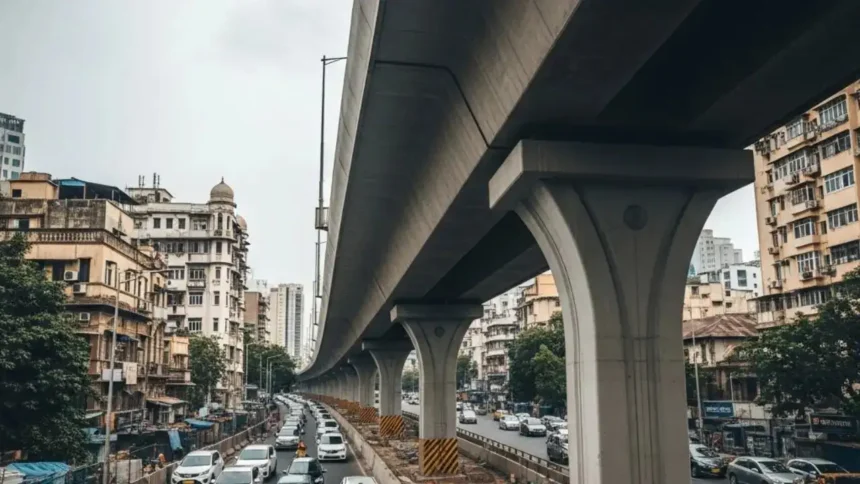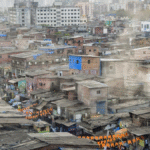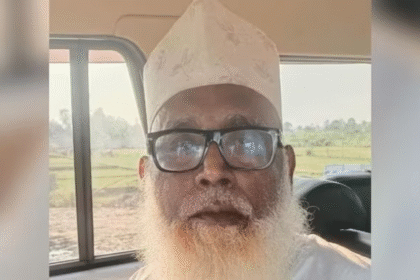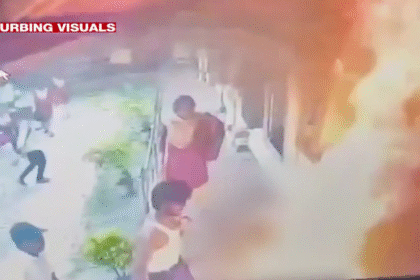Mumbai’s Sindoor Flyover — A New Chapter in Urban Connectivity
On the bustling morning of its inauguration, Mumbai’s newly constructed Sindoor Flyover opened its arms to thousands of commuters, officially marking the replacement of the city’s century-old Carnac Bridge. In a metropolis where every minute lost in traffic translates to hours of collective inefficiency, the Sindoor Flyover is more than a piece of infrastructure—it is a symbol of Mumbai’s effort to reimagine its aging urban spine.
The Carnac Bridge, originally constructed in the 1860s by the British, had long served as a key arterial link between the city’s eastern docks and its southern core. Over the decades, it became a part of the daily rhythm of Mumbai’s central business district, connecting Chhatrapati Shivaji Maharaj Terminus (CSMT) to the eastern waterfront and facilitating vital movements of goods, services, and people. But like much of Mumbai’s colonial-era civic infrastructure, time eventually caught up with it. Structural weaknesses, stress from overloaded traffic, and delayed maintenance forced authorities to dismantle the bridge in 2023 after years of deliberation and safety concerns.
In its place now stands the Sindoor Flyover, designed not just to replace what once was, but to carry the city into what it must become. Built with contemporary materials, seismic-resistant engineering, and optimized for multimodal traffic, the flyover is part of the Maharashtra government’s broader push to modernize city infrastructure while tackling chronic traffic congestion in South Mumbai.
Spanning across multiple key junctions, the new flyover connects P D’Mello Road with the city’s eastern docklands and central railway lines more seamlessly than ever before. It allows smoother traffic flow from areas like Mazgaon, Dockyard Road, and Byculla into the heart of Mumbai’s financial district, significantly reducing travel time during peak hours. For the estimated 1.2 lakh vehicles that use this corridor daily, the flyover promises relief not just from traffic snarls, but from decades of infrastructural stagnation.
But its significance runs deeper.
In many ways, the opening of the Sindoor Flyover is a reflection of how Mumbai is balancing heritage preservation with modernization. While the demolition of the historic Carnac Bridge stirred emotional responses and concern from conservationists, city planners emphasized the necessity of evolution. “You can’t run a 21st-century city on 19th-century foundations,” said a senior official from the Brihanmumbai Municipal Corporation (BMC). “The idea was not to erase the past, but to upgrade what’s necessary without forgetting what came before.”
The naming of the flyover as ‘Sindoor’, believed to signify renewal and energy, also reflects the civic body’s effort to inject local symbolism into infrastructure naming—a move both cultural and political, aimed at connecting with the Marathi-speaking population and aligning with broader identity narratives in the state.
Critics, however, point to the timeline and cost overruns that delayed the project by more than 18 months and pushed the final cost nearly 20% over budget. Several local shopkeepers and residents in the area complain that the extended construction period led to a loss in foot traffic, affected their businesses, and made access to nearby localities difficult. Others raise concerns about pedestrian accessibility, noise pollution, and whether the flyover truly integrates with the city’s multi-modal transport vision—which includes the upcoming Mumbai Metro lines, BEST electric buses, and the railway modernization plan.
Even so, there is little doubt that for now, the Sindoor Flyover offers a much-needed breather. On the first day of its opening, traffic along the CSMT-Mazgaon corridor was reported to be moving 28% faster than on an average weekday. Emergency vehicles, delivery trucks, and daily office commuters found the ride smoother, with fewer bottlenecks and clearer access to eastern docks and arterial roadways.
Yet, as the flyover begins its role in Mumbai’s urban narrative, questions remain: How will the surrounding road network absorb the redistributed traffic? Will the new structure remain sustainable in the face of monsoon flooding and future surges in vehicle volume? Will maintenance routines be followed, or will the flyover eventually meet the same neglect as its predecessor?
Every flyover is more than a physical structure—it is a product of governance. The Sindoor Flyover, now easing daily travel for tens of thousands in South Mumbai, represents the culmination of years of civic planning, inter-agency negotiations, political pressure, legal hurdles, and persistent delays. In Part 2, we step behind the scenes to understand how such a project comes to life in a city as complex as Mumbai.
The demolition of the Carnac Bridge had long been on the cards. As early as 2014, the Indian Railways, which owned the structure, flagged its deteriorating condition in structural audit reports. Trains running below were deemed at risk, and the bridge itself—originally meant for light horse-drawn carriages—was struggling under modern vehicular loads. But warnings were repeatedly delayed or dismissed due to bureaucratic red tape and competing jurisdictional claims between the Railway Ministry, BMC, and Maharashtra Urban Development Department.
In 2022, after a high court order and repeated inspections, authorities finally moved to dismantle the bridge. What followed was a textbook case of inter-departmental coordination challenges. The demolition was executed in a high-risk zone above Mumbai’s busiest railway corridor—between CST and Dockyard Road—and required precise timing to minimize disruption. The railways insisted on minimal blockades. The traffic police demanded alternative routes. Local residents wanted minimum noise at night. Contractors needed clearances. The BMC had to mediate between all of them while sticking to a timeline that was politically sensitive ahead of state elections.
And that’s where the real story begins.
The Sindoor Flyover wasn’t merely a civic response to a collapsed structure—it became a political project. In Mumbai, where every large-scale urban intervention is subject to electoral scrutiny, infrastructure is no longer neutral. The decision to name the flyover “Sindoor” was a deliberate attempt to embed cultural identity into the city’s developmental vocabulary. While some saw this as symbolic empowerment, others criticized it as politicization of public works. Regardless, it helped secure rapid administrative approvals and mobilized funding in record time—ironically, the very thing that had eluded the Carnac Bridge’s timely maintenance for years.
The flyover was built under the Mumbai Urban Infrastructure Project (MUIP), a public-private urban mobility initiative launched in partnership with the state government. The contractor—selected through a competitive bidding process—had previously worked on projects like the Delisle Road overpass and the Eastern Freeway Extension. Yet, despite these credentials, the Sindoor project suffered a nearly 15-month delay due to monsoon disruptions, supply chain issues during COVID-19 recovery, and disputes over access to land parcels adjoining the original Carnac Bridge footprint.
One of the most under-reported aspects of the project was the resettlement of affected vendors and residents. Small shops, hawkers, and commercial kiosks operating around the old bridge were issued temporary relocation notices. While compensation was offered on paper, implementation was uneven. Many small business owners, particularly near Masjid Bunder and P D’Mello Road, complained of being sidelined with vague promises and minimal public consultation. Their plight underscores a recurring challenge in Mumbai’s infrastructure expansion—the silence around micro-displacement.
Despite these challenges, the project is now a functioning reality. Much of the credit, insiders suggest, goes to a small group of mid-level engineers and IAS officers who worked behind the scenes. From coordinating rail blocks at midnight to securing approvals from the Ministry of Road Transport & Highways (MoRTH), they pushed the files that built the flyover. It is this often invisible layer of Mumbai’s governance structure—technical but thankless—that keeps the city moving, quite literally.
However, the flyover’s completion should not be seen as a one-off triumph. It exposes long-standing flaws in Mumbai’s project delivery framework: lack of transparency, poor stakeholder communication, excessive centralization of decision-making, and weak accountability for delay or cost escalation. It also reaffirms the urgent need for a modernized civic governance model—one where project execution is proactive, not reactive.
In that sense, the Sindoor Flyover is both a case study in what’s possible and a warning of what’s at stake.
When the first wave of vehicles rolled over the newly opened Sindoor Flyover, the impact was immediately visible—not just in reduced travel times, but in the psychology of a city long fatigued by traffic chaos. For thousands of daily commuters who traverse Mumbai’s historically congested eastern corridor, the new flyover isn’t just a roadway—it’s a shift in the urban rhythm.
Strategically located to bridge one of the city’s most vital arterial stretches—between Chhatrapati Shivaji Maharaj Terminus (CSMT) and the eastern docks via P D’Mello Road—the Sindoor Flyover plays a crucial role in realigning South Mumbai’s traffic flows. For decades, this area bore the burden of mixed traffic: commercial trucks heading to the port, taxis weaving toward the railway station, buses pushing through narrow lanes, and private vehicles trying to escape the bottlenecks of Masjid Bunder. The demolition of the old Carnac Bridge only worsened the gridlock, displacing pressure onto already saturated internal streets.
With the inauguration of the Sindoor Flyover, traffic engineering officers at the Mumbai Traffic Police have reported a reduction of over 25% in surface congestion during peak hours in the Dockyard Road-CSMT stretch. Vehicles now bypass multiple junctions and signalized intersections, drastically cutting idling time and emissions. In effect, the flyover has carved a fast-track channel above one of Mumbai’s most choked thoroughfares.
But the benefits are not limited to vehicles alone.
The flyover has enabled streamlined access for emergency services, particularly ambulances and fire brigades, which earlier struggled to navigate the tightly packed lanes around Masjid Bunder and Nagpada during emergencies. Now, with an elevated and clear passage, response times in that zone are expected to improve by 20–30%, a life-saving difference in a city where every second counts.
For public transport users, however, the story is more nuanced. While private vehicle users enjoy uninterrupted rides, BEST bus routes that previously shared the lower-level roads have not yet been fully integrated into the elevated corridor. As a result, buses still face congestion at grade-level junctions, though the overall load on surface roads has decreased. There are discussions underway within the BMC’s transport planning division to explore limited bus integration onto the flyover—at least for express services connecting South Mumbai with the Eastern Freeway and Navi Mumbai.
Urban planners are also examining how the flyover fits into the multi-modal ecosystem of the city. With the expansion of Mumbai Metro Lines 2B and 4, and the development of new mobility hubs in Wadala and Sewri, the eastern corridor is becoming increasingly transit-rich. The Sindoor Flyover, while car-centric by design, intersects with key roadways that feed into metro stations, upcoming monorail routes, and even ferry jetties at Princess Dock. This opens up the possibility of a transport integration plan that could connect elevated road transport with rail and water-based systems.
Yet, some mobility experts have raised concerns about long-term sustainability. Dr. Shubha Kale, an urban transport researcher at CEPT University, points out that while flyovers provide short-term relief, they often induce additional demand. “Once traffic begins to flow faster, more people are encouraged to take their vehicles, eventually filling up the new capacity,” she explains. This phenomenon—known as induced traffic demand—has been observed in cities like Los Angeles and Beijing, where elevated corridors temporarily solved congestion only to recreate it a few years later at a larger scale.
What can mitigate this effect is smart traffic management. Already, the Mumbai Traffic Police, in collaboration with the MSRDC, is piloting adaptive signal systems and AI-powered traffic cameras to manage inflows and prevent bottlenecks at the flyover’s exit ramps. Sensors are also being tested to monitor real-time vehicle volumes, feeding data into a central dashboard that can assist in urban transport modeling for future projects.
Perhaps one of the most overlooked benefits of the Sindoor Flyover is its potential to improve last-mile connectivity. Local stakeholders, including residents’ associations from Fort, Dockyard, and Mandvi, have suggested the development of skywalks, bicycle zones, and pedestrian underpasses alongside the flyover to create safe, walkable linkages. If implemented, this could transform what is currently a vehicle-dominated corridor into a more balanced, multi-user urban artery.
But such initiatives require funding, political will, and continued civic pressure.
As it stands today, the Sindoor Flyover is functioning as a high-efficiency bypass, redistributing traffic, saving time, and injecting speed into a historically gridlocked zone. Its full potential, however, will only be realized if future urban mobility planning places equal weight on accessibility, sustainability, and inclusion.
The opening of the Sindoor Flyover has been celebrated as a much-needed infrastructural upgrade, but it also marks the quiet erasure of one of Mumbai’s oldest and most historically significant structures—the Carnac Bridge. For over 150 years, the Carnac Bridge wasn’t just a functional crossing point; it was a part of Mumbai’s urban story, a relic from the British era, and an enduring symbol of the city’s industrial-age birth. Its demolition—though necessary from a structural and safety standpoint—has reopened a long-standing debate: How should a rapidly modernizing Mumbai treat its heritage?
Originally constructed in the 1860s, the Carnac Bridge was named after James Rivett Carnac, a British colonial administrator and one-time Governor of Bombay. It was among the earliest railway overpasses built in India, spanning the lines emerging from Victoria Terminus (now Chhatrapati Shivaji Maharaj Terminus or CSMT), which itself is a UNESCO World Heritage Site. The bridge connected the bustling commercial heart of the city with its emerging eastern docklands, facilitating the movement of not only carriages and carts, but also generations of workers, traders, and dockhands who built the city’s commercial legacy.
Over time, as Mumbai expanded vertically and horizontally, the Carnac Bridge remained a stoic reminder of a bygone era. Its worn-out girders, cobblestone bases, and cast iron railings were physical testaments to engineering craftsmanship of the colonial period—rare to find in a city that often builds over its past instead of preserving it.
When the demolition decision was made in 2023, heritage conservationists and civic activists objected strongly. Organizations like INTACH (Indian National Trust for Art and Cultural Heritage) and the Mumbai Heritage Conservation Committee appealed for documentation, digital archiving, and even partial preservation of architectural elements. Some proposed turning parts of the bridge into a pedestrian promenade or open-air museum, integrating history with function—a model followed in cities like London, Paris, and Istanbul.
However, pragmatism won. Structural safety reports from the Railways classified the bridge as “beyond salvage,” citing corrosion, material fatigue, and risk to the suburban rail network below. Public safety became the overriding concern, and despite emotional and symbolic resistance, the bridge was dismantled piece by piece over several months.
To its credit, the BMC did document portions of the bridge, and some original iron columns have reportedly been stored for potential reuse in public art or historical exhibits. But critics argue that this is too little, too late. The lack of a strong, codified policy for heritage structures that are not on the official “protected list” means that many such relics, especially industrial or utilitarian ones, are lost quietly in the name of progress.
The debate extends beyond Carnac. Over the last two decades, Mumbai has lost or drastically altered several historic structures—Elphinstone Bridge, Old Hancock Reservoir domes, and parts of the Esplanade Mansion, to name a few. While colonial architecture in South Mumbai’s Fort area receives legal and civic attention, infrastructure such as old bridges, tram sheds, and railway bungalows rarely receive the same degree of protection—even though they tell an equally important story of Mumbai’s urban evolution.
The Sindoor Flyover, by contrast, is a monument to speed, efficiency, and growth. It has been built with performance and pressure in mind, designed to withstand modern vehicular loads and seismic activity. Yet, it lacks the character, memory, and architectural imprint of the bridge it replaces. And this speaks to a deeper concern: Can Mumbai modernize without erasing the very foundations it was built on?
Some cities have found ways to integrate past and future. In Barcelona, old aqueducts are embedded into metro stations. In Shanghai, colonial facades are preserved even as glass towers rise behind them. In New York, elevated rail lines have been converted into public parks like the High Line. Mumbai, with its layered history and intense developmental pressure, must find its own path forward.
In this regard, the Sindoor Flyover serves as both a success story and a cautionary tale. It reflects what Mumbai can accomplish when political will and civic urgency align. But it also shows what the city might lose in the process if it fails to document, debate, and value its heritage alongside its hunger for progress.
Also Read : Angst of an Army Veteran: Lt Gen Zameer Uddin Shah Speaks Out on Growing Communal Intolerance in India








